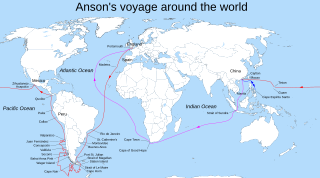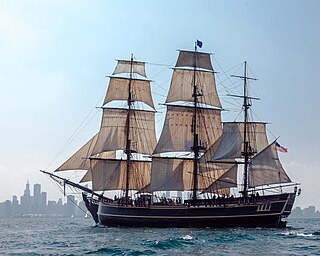
Sailing employs the wind—acting on sails, wingsails or kites—to propel a craft on the surface of the water, on ice (iceboat) or on land over a chosen course, which is often part of a larger plan of navigation.

A dory is a small, shallow-draft boat, about 5 to 7 metres or 16 to 23 feet long. It is usually a lightweight boat with high sides, a flat bottom and sharp bows. It is easy to build because of its simple lines. For centuries, the dory has been used as a traditional fishing boat, both in coastal waters and in the open sea.

The Love Boat is an American romantic comedy-drama television series that aired on ABC from September 24, 1977 to May 24, 1986. In addition, three TV movies aired before the regular series and four specials and a TV movie aired after it. The series was set on the luxury passenger cruise ship MS Pacific Princess, and revolved around the ship's captain Merrill Stubing and a handful of his crew, with passengers played by guest actors for each episode, having romantic, dramatic and humorous adventures.

The Zong massacre was a mass killing of more than 130 enslaved African people by the crew of the British slave ship Zong on and in the days following 29 November 1781. The William Gregson slave-trading syndicate, based in Liverpool, owned the ship as part of the Atlantic slave trade. As was common business practice, they had taken out insurance on the lives of the enslaved Africans as cargo. According to the crew, when the ship ran low on drinking water following navigational mistakes, the crew threw enslaved Africans overboard.
The Banks dory, or Grand Banks dory, is a type of dory. They were used as traditional fishing boats from the 1850s on the Grand Banks of Newfoundland. The Banks dory is a small, open, narrow, flat-bottomed and slab-sided boat with a particularly narrow transom. They were inexpensive to build and could be stacked or nested inside each other and stored on the decks of larger fishing vessels which functioned as mother ships.

The United Kingdom Hydrographic Office (UKHO) is the UK's agency for providing hydrographic and marine geospatial data to mariners and maritime organisations across the world. The UKHO is a trading fund of the Ministry of Defence (MoD) and is located in Taunton, Somerset, with a workforce of approximately 900 staff.
F/VAndrea Gail was an American commercial fishing vessel that was lost at sea with all hands during the Perfect Storm of 1991. The vessel and her six-man crew had been fishing the North Atlantic Ocean out of Gloucester, Massachusetts. Her last reported position was 180 mi (290 km) northeast of Sable Island on October 28, 1991. The story of Andrea Gail and her crew was the basis of the 1997 book The Perfect Storm by Sebastian Junger, and a 2000 film adaptation of the same name.

Spray was a 36-foot-9-inch (11.20 m) sailboat owned and used by Joshua Slocum, a 19th-century Canadian-American seaman and author. Slocum rebuilt and sailed the ship around the world solo. On the morning of April 24, 1895, the Spray, with Slocum at the helm, departed from Boston Harbor. On June 27, 1898, Slocum sailed the Spray into the harbor at Newport, Rhode Island, becoming the first man known to have sailed around the world alone.

Effie M. Morrissey is a schooner skippered by Robert Bartlett that made many scientific expeditions to the Arctic, sponsored by American museums, the Explorers Club and the National Geographic Society. She also helped survey the Arctic for the United States Government during World War II. She is currently designated by the United States Department of the Interior as a National Historic Landmark as part of the New Bedford Whaling National Historical Park. She is the State Ship of Massachusetts.
The sport and practice of single-handed sailing or solo sailing is sailing with only one crewmember. The term usually refers to ocean and long-distance sailing and is used in competitive sailing and among Cruisers.

SS Manhattan was an oil tanker constructed at the Fore River Shipyard in Quincy, Massachusetts, that became the first commercial ship to cross the Northwest Passage in 1969. Having been built as an ordinary tanker in 1962, she was refitted for ice navigation during this voyage with an icebreaker bow in 1968–69. Registered in the United States at the time, she was the largest US merchant vessel. If we consider ice navigation vessels as icebreakers, then Manhattan was the biggest icebreaker in history before the construction of the Yamalmax class ships.

While Great Britain was fighting the War of Jenkins' Ear with Spain in 1740, Commodore George Anson led a squadron of eight ships on a mission to disrupt or capture the Pacific Ocean possessions of the Spanish Empire. Returning to Britain in 1744 by way of China and thus completing a circumnavigation of the globe, the voyage was notable for the capture of the Manila galleon, but also for horrific losses from disease with only 188 men of the original 1,854 surviving. An account of the voyage was published in 1748 which being widely read by the general public was a great commercial success and "is still esteemed as the story of a remarkable voyage extremely well told."

The schooner Hannah was the first armed American naval vessel of the American Revolution, authorized by the Continental Congress and operated by the Continental Army, and is considered by some the first vessel of the United States Navy. She was a fishing schooner owned by John Glover of Marblehead, Massachusetts and was named for his daughter, Hannah Glover. The crew was drawn largely from the town of Marblehead, with much of the ships ammunition being stored in Glover's warehouse now located at Glover's Square in Marblehead before being relocated to Beverly, Massachusetts.
The Second Voyage of the Mimi is a twelve-episode American educational television program depicting a fictional crew of a sailboat named the Mimi exploring Mayan ruins in Southern Mexico. Along the way, they learn about ancient civilization and also attempt to foil the plans of looters who steal the artifacts from the ancient sites. This series is a sequel to The Voyage of the Mimi, produced in 1984, in which the Granvilles rented their boat and services to zoologists studying the humpback whale in the waters off Massachusetts.

Bounty was an enlarged reconstruction of the original 1787 Royal Navy sailing ship HMS Bounty, built in Lunenburg, Nova Scotia, in 1960. She sank off the coast of North Carolina during Hurricane Sandy on October 29, 2012.

Mighty Ships is a documentary television program produced by Exploration Production Inc. in Canada and aired on Discovery Channel Canada and also broadcast around the world. Each episode of the series follows a particular sea-going vessel and provides an insight into the ship and its crew.

The Friendship of Salem is a 171-foot replica of the Friendship, a 1797 East Indiaman. It was built in 2000 in the Scarano Brothers Shipyard in Albany, New York. The ship usually operates as a stationary museum ship during most of the year. However, it is a fully functioning United States Coast Guard-certified vessel capable of passenger and crew voyages, which makes special sailings during various times of the year. The Friendship of Salem is docked at the Salem Maritime National Historic Site, established in 1938 as the first such site in the United States. The site, which includes several structures, artifacts and records, is operated by the National Park Service.

RV Gloria Michelle (F7201), sometimes rendered as R/V Gloria Michelle, is an American fisheries research vessel in non-commissioned service in the National Oceanic and Atmospheric Administration (NOAA) fleet since 1980. Prior to her NOAA career, she was a commercial shrimp boat that came into the possession of the United States Government after her seizure for carrying marijuana.

The Ross expedition was a voyage of scientific exploration of the Antarctic in 1839 to 1843, led by James Clark Ross, with two unusually strong warships, HMS Erebus and HMS Terror. It explored what is now called the Ross Sea and discovered the Ross Ice Shelf. On the expedition, Ross discovered the Transantarctic Mountains and the volcanoes Mount Erebus and Mount Terror, named after each ship. The young botanist Joseph Dalton Hooker made his name on the expedition.
Peter G. Marston was an American scientist, businessman, actor, and musician. He served as chief executive officer of Cambridge Environmental Technology and held a visiting professorship at the Massachusetts Institute of Technology, in the Plasma Science and Fusion Center. Marston also served as a member of the Moscow-based International Academy of Electrotechnical Sciences.















